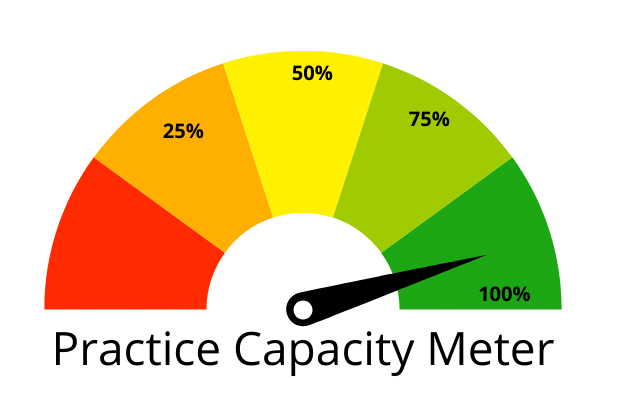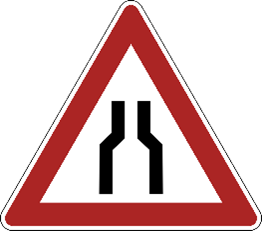Do you work hard but you just don’t get as far as you should? The reason may be that you are running into unseen bottlenecks that are choking off your production and suffocating your growth.
Here is an example: One doctor we worked with a few years back had a small office of about 1000 square feet. He was seeing about 140 visits week but wanted to see more. He felt the problem was not enough promotions generating more new patients.
We visited his office and noticed that he already had a decent amount of marketing underway and he was getting external new patients. While his marketing could have been more effective, it wasn’t that bad.
We noticed that the reception area was tiny and mentioned this to the doctor and suggested he move to a larger office. He had his mind made up. He did not want to get a larger office because he had heard of doctors seeing 300 O.V.’s per week in 1000 square feet with very low overhead and he wanted to do the same.
So we set up a special focus group and personally interviewed his patients. The primary complaint was that the reception area was too small. The patients interviewed said that during peak hours there was no room for them to sit. They said that they felt that he must be too busy and therefore they would not come in to see him because he was full, and that they referred their friends to other offices.
Well, with this information, the doctor finally decided to move into a new office with a larger reception room. Shortly thereafter, his office visits shot up to an average of 225 per week.
There are a number of lessons to learn from this story. One being not having a fixed opinion of how things should be based upon hearsay, or what may work for one doctor may not work for you. But the biggest lesson has to do with capacity. And, there are many examples of capacity restraints that we often uncover in our consulting and coaching work over the years.
Bottlenecks can occur at the front desk, in the therapy area, and in the insurance department. They can occur with the patient flow, with paperwork or in doctor time.
The theory of capacity management, as expounded by Eli Goldratt and explained in his books, including the best selling The Goal, discusses the theory of capacity constraints as applied to a manufacturing environment. The same principle applies to a health care facility.
According to Goldratt:“Capacity is the available time for production.” A bottleneck is: “what happens if capacity is less than demand placed on resource.”
SOME CHIROPRACTIC EXAMPLES:
- Peak Periods. Between the 4-6 pm slot, where there is extra traffic, additional staff or increased capacity is not always provided. If staff feel that patients are waiting too long, or that they are not able to handle all the traffic, they may unconsciously hope the phone does not ring or another patient walks in. In turn, should someone new call or walk in, the quality of service may be poor.
- Paperwork. Older forms may not meet the current needs, be redundant or even hard to read.
- Poor scheduling of patients: (not cluster booked, not booking for NP or paperwork)
- Doctors waiting for therapy patients. (No therapy staff or therapy after adjustment)
- Front Desk doing insurance and scheduling at each visit (no multiple appointment plan or Prepayment plan)
- Not enough exam rooms
- Clutter in front desk/insurance area
- Quitting time. After a long day, all staff and doctors are looking forward to leaving and really don’t want extra patients to call or come in.
- Backlogs. Undone reports from two summers ago, partially completed projects, cluttered desks or office space, all discourage an increase in production. You only have so much mental capacity, and if it gets frittered away on projects that are not completed, you will have “too many irons in the fire” to add any more
- Doctor talking too much. “Table talk” should be about chiropractic, the patient’s need for care, their progress, and referrals. Now and then, a few questions about the patient’s personal life to demonstrate your genuine interest is good. Aside from that, there is no need to justify your services with lots of talking. Keep it moving.
- “Difficult people”. Some staff, or patients, will seem to drain you of your energy, or consume too much of your time trying to keep them happy. This can “clog” up your day.
- Doctor too busy doing administrative tasks and micro managing. This distracts him from the work that he needs to do.
- Doctor’s mind “filled up” with lots of experience and no longer curious or interested in practice.
SIX CATEGORIES OF CAPACITY IN A CHIROPRACTIC OFFICE: We can break practice capacity constraints into 6 categories.
- Physical. (For example, not enough rooms, rooms too small, or just too cluttered.)Doctor. (For example, doctor doing billing, answering phones, and micro managing. )
- Procedural. (E.G. making 4 copies of each EOB rather than making an electronic back up)
- Equipment. (For example, using hand feed copier rather than an automatic feeder.)
- Personnel. (Not enough staff, poorly trained staff, barely competent staff preventing you from hiring superior staff, and negative staff, etc.)
- Doctor. (For example, doctor doing billing, answering phones, micro managing, head “filled” with “krap!” )
REMOVING PRACTICE CONSTRAINTS
Here are some steps to take to remove bottlenecks.
First, start by determining what is the maximum number of patients that could be seen by the doctor if all he or she did was adjust or treat them. What is the doctor’s capacity in terms of visits? E.G. 250 visits per week – if all she did was adjust, do SOAPs, exams, and report of findings, with 6 New Patients and 5 returning or re-injured patients.
Then, look at what eats up the doctor’s time. Then, consider the flow of patients, of paper, and anything that slows it down or gets in its way. Consider patients waiting, paperwork waiting, and any times of the day or days during the week where there is a slowdown or backlog. Honestly check each category below.
Once you do this, have a staff meeting, explain the concept, and get responses from the staff.
- Doctor’s time: What does he do other than adjust patients? Can it be delegated? Can scheduling be improved so that the doctor never waits? Does she have any redundant tasks that can be made into a routine template?
- Procedures: Are there redundancies? Is something being done that could be done faster?
- Personnel: More training needed, more staff needed, better attitudes needed?
- Physical space: Do you need more space? Could things be arranged differently for greater efficiency?
- Equipment: Could a new piece of equipment speed things up? Does anything need fixing?
Once you have done this, give yourself 30 days to fix the biggest capacity constraint. Then, reassess. If the constraint is fixed and the flow is improved in that one area, it may have migrated to another area.
For example, a doctor was doing all of the x-rays which took extra time and she was also waiting for patients because they were not “cluster” booked. Solution: staff did all the x-ray work and the doctor just came in, checked, and “pushed the button.” The front desk booked the patients tightly so that the doctor did not have gaps in her schedule. Visits increased by 40 per week, from 160 to 200 for the week because now there was more “room.”
However, now that this was fixed, the bottle neck may “migrated” to another part of the office. Now, the insurance department can’t keep up with the extra work and a backlog starts to build up in this area. If this does not get fixed, then the insurance department’s traffic will slow down, like a traffic jam, and the office visits will eventually go back down to 160 per week.

When your business is not expanding like you feel it should, you may have bottlenecks or hidden logjams choking and stunting your growth. Fixing these and opening up the flow, even at extra cost, will usually greatly increase production and income and be worth it.
If it doesn’t get fixed soon, give us a call.
Sometime
(copyright Petty Michel & Associates 8/27, 2007. Revised 2012. CHMS, Inc.)




